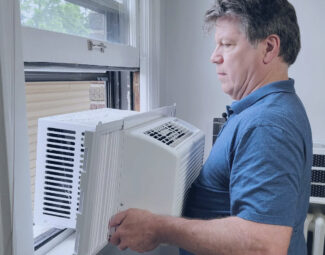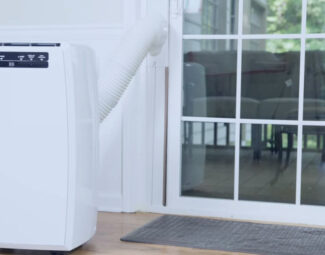S ummer is the most awaited season of the year. It arrives with pool parties and barbecues, long walks on the beach, or an exciting RV trip. The clothes are light and thin, and you don’t need to carry heavy coats anymore. However, one thing is always present and may get too much at some point. We are talking about the heat. With the sun burning more hours a day, everything gets hot: the cement in your patio, the walls, the air, and this will reflect upon your thermal comfort.
Fortunately, it is almost incredible how many devices have been built to fight the heat, from ceiling fans that circulate the air and don’t give it the chance to get hot, to air coolers that come in all kinds of shapes to cast the heat away.
Today, we will focus our attention on two particular types of ACs, namely window and portable units. We will compare their performance and costs and try to determine which can bring you higher benefits, so follow our analysis and pick the right model.
Why Go for a Single Room Air Conditioner?
There’s nothing wrong with whole-house AC systems, which can provide excellent coverage for large spaces, but when you spend most of the time in one room, it may be a waste of money to remove heat in the entire living space. This is the exact purpose for which single-room ACs were invented.
Central HAVC systems are not always as uniform as the manufacturers claim. Leaks or poor house insulation can lead to improper cooling in some rooms while others become cooler than they should. Moreover, they are more difficult to maintain and more expensive to buy. Single-room ACs, on the other hand, are an alternative that will save you money.
Check out the quietest window ACs if you wish to keep your bedroom cool and get some sleep at the same time.

Man Padding Window Air Conditioner Gap
Window AC
The main criteria you need to consider before deciding on this type is if you have a window available. At the same time, it is essential to assess if it is wide and tall enough to allow the set up of the unit. Once you have checked and established that your room is compatible with a window AC, you can pick the model that suits you best and enjoy the coolness.
How does a window AC work?
Mechanism Explained – the Short Way: It uses a blower to draw the hot air inside and a system formed of a compressor, a condenser, and an evaporator to cool the air down and release it back into the room. The warmth is blown out through the back of the unit.
The Long Explanation:
- The unit starts drawing the hot air inside its mechanism. It will first go through a filter, which acts as a barrier against dust and other pollutants. At the same time, inside the unit, the refrigeration process is initiated;
- The refrigerant is first turned from a hot liquid into vapors. Then it enters the compressor which increases its pressure and sends it to the condenser’s coils. Here, the vapors hit the cold coils and condensation happens. The refrigerant liquid loses its heat and turns back into a liquid;
- The liquid will further go through an expansion valve, which decreases its pressure and reduces its temperature even more, making it extremely cold. Then, the refrigerant goes back into the condenser;
- It cools the coils, preparing them for when they meet the hot air. Condensation occurs once again, but this time, the heat from the air along with the moisture is extracted;
- The coolness is released back into the room and a new cycle is about to begin until the desired temperature is attained.
The shape of the window is essential when dealing with window models. Check out these vertical window ACs as they offer you the possibility to open the window.
The benefits:
- Quick installation - You don’t need to create a special opening for it as you will use the window as the opening. Plus, it is self-contained, so once you get it fixed on the spot, you just need to turn it on and wait for the air to become cooler.
- Versatile - It will fit in almost any space that has a window. Therefore, you can place it in an office or a bedroom or as a complementary cooling source in a room that is detached. For example, if your entire home is cooled by a central HAVC system, but the duct won’t reach the garage, you can use it to provide better comfort while you get busy with your DIY or restoration projects.
- Affordable - It is less expensive than central HAVC and portable alternatives, so it is the best option when it comes to saving money. The price of a unit of this kind can vary from under $100 to $700-$800, depending on its power and quality.
- Space-saving - You may think that a bulky thing in your window can hardly be considered a space saver, but when you compare it with a portable AC that cuts on your floor space, you will understand that this model is more suitable for small rooms.
The drawbacks:
- Will remove heat only in small spaces - It is designed for tight spaces and most probably won’t handle a large room. If you find a model that has this power though, the costs of running it will be noticeable
- Noisy operations - It uses a fan, so you should expect some noise, which is usually white, but still can disturb you if you are a sensitive sleeper
- Takes up window space - You won’t be able to open the window and a large unit will cover a considerable part of it. Plus, in most cases, the units are bulky and not pleasantly appealing
- It cannot always be installed - The building administration may not allow the mounting of window model or you may not have access to a window.

Single-Hose Portable Air Conditioner in Living Room
Portable AC
You will appreciate that it doesn’t need to be installed. Well, you will need to provide a window for the hose, and in some cases a floor drain, but the unit is self-contained so you won’t need to pull out the heavy tools like a screwdriver or a wrench.
Check out these small portable AC reviews, built to provide excellent air cooling and dehumidification in small spaces.
How does a portable AC work?
Regarding the functioning principle, it is the same as in the previous case. It comes with a fan, a compressor, a condenser, and an evaporator, which circulate the refrigerant turning it from a hot liquid into a gas and then into a cool liquid, a process that leads to air cooling and dehumidification through condensation.
However, some differences do exist:
Water Disposal Methods
Window models will evacuate all the water that results from condensation outdoors but portable units may need a little more assistance on your part, depending on their drainage system:
- Bucket Units - Manual water removal is highly uncomfortable. This is why it is highly unlikely to find it in new units. Nevertheless, in older units, a bucket is used to collect the water which will need to be removed periodically, sometimes more than twice a day.
- Continuous Drain - It is a more comfortable alternative to manual draining, but it requires the presence of a floor drain or a sink for the water to be removed. In some cases, if the water needs to be pushed vertically or horizontally, a pump may be required.
- Evaporative Models - The newest models use the water from condensation to cool their coils and remove the rest of it through the hose, so you won’t need to put up an effort anymore.
One-Hose vs. Two-Hose Systems
The first type will use the same path to draw the hot air and release the cool air, while the second option will come with a separate hose for each operation, so it is usually more energy-efficient and faster in its process.
The benefits:
- It installs in minutes - It comes with a kit that will help you fix the hose in a few minutes
- Easy to move around - If you move a lot, you will appreciate that you can take your AC with you. Moreover, you can easily change the room where it cools the air, or use it as a complementary cooling means to the central HAVC system.
- Energy-efficient - Especially if you pick a two-hose model, your energy costs will be lower compared with similar air cooling alternatives.
- No restrictions - If in some cases you may be prevented to install a window model, no one can stop you from using a portable unit. It the hose is installed correctly, it won’t be visible from the outside.
The drawbacks:
- Requires a vent - It must get rid of the warm air, so an opening for the hose is compulsory
- Takes floor space - Although these units are built to be as tight as possible, they will cut on your floor space. Plus, they are not the sleekest items on the market, and one or two hoses will certainly not look amazingly in your bedroom.
- The noise is noticeable - Unless you like white noise, you will probably find it disturbing during the night, even when it is operating at low speed. Nevertheless, these units tend to be quieter than window models.
- Some models need to be drained - Whether it is a continuous drain or a bucket, it is still a bother. Nonetheless, you can opt for a more advanced unit and overcome this drawback.
Portable AC vs. Window AC – Which Is a Better Pick?
What needs to be remembered is that both these systems are built to cool a single room and can be relocated if necessary. But only one can go with you to any place you need it, even in your RV, and this is the portable model. It doesn’t depend on any regulations as it doesn’t hang on the exterior of the building and can be set up in a moment. You need though to ensure a vent for it to release the hot air. Furthermore, if you pick a more expensive model, you won’t need to deal with water drainage, which was for sure a serious drawback in the past.
Window units, on the other hand, are known to be more energy-effective, so you will get more BTUs for the same energy cost. But this is mostly the only thing for which you should consider buying one of these models. They are more difficult to move and install, and if you consider relocation, the new building may come with regulations against window AC, and your device will become useless. Plus, they block the window and are rather unaesthetic.
A variant to window models is a through-the-wall AC, which will leave your window free. However, you will need to cut an opening in the wall and, in some cases, buy the installation kit. These models, however, take less space than any other AC model, so they are an excellent choice for tiny rooms.
The Bottom Line
Understanding how each of these machines works and the benefits it can bring is essential to determine which will suit your space better. Now that you have had the chance to analyze the subtypes and the requirements that need to be accomplished before installing them, it should be easier for you to decide what to buy. Nevertheless, you should remember that these devices have a triple or even quadruple function. They cool the air but they circulate, dehumidify, and filter it as well, so they are totally worth every penny.












